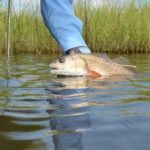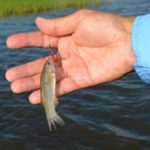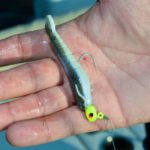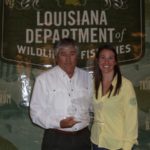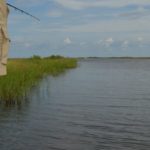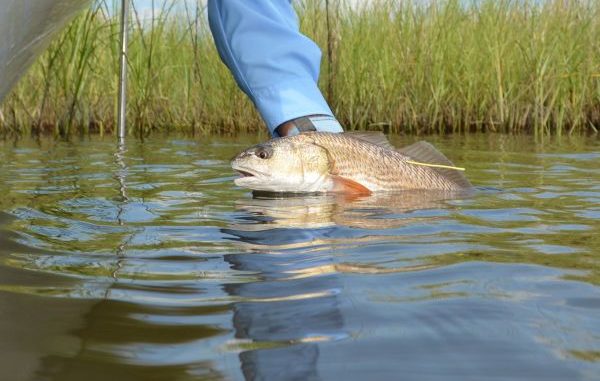
One of the most-proficient redfish tagging volunteers in the state shares how he catches so many fish in his Leeville hang-out.
“Local Angler Recognized as Top Tagger,” the banner in the Era Leader, Washington Parish’s weekly newpaper, read.
Bob Bateman wasn’t hard to find. Franklinton, the parish seat where he lives, has only 3,809 people.
A phone call to him revealed an open kind of guy, one who wasn’t hesitant to reveal his “secrets.”
He began saltwater fishing in the late 1960s with Herb Miller, the owner of the Ford dealership in Franklinton and whose son Dale was about Bateman’s age. They fished the Fourchon area.
He dropped out of saltwater fishing for a while to chase largemouth bass, but a little over 25 years ago he came back and has been at it ever since.
“I enjoy being in the marsh,” Bateman said. “It’s not just about catching fish; it’s about being out there. My wife Carol fishes with me a lot, especially in spring and fall.
“Carol would say I fish every weekend, but I do miss a few.”
But he admitted to fishing 30 days a year — “easily.”
He catches a lot more fish than he can eat, which is partially what led him to become part of Tag Louisiana, the Louisiana Cooperative Marine Fish Tagging Program. The program is a joint effort of the Louisiana Department of Wildlife and Fisheries, and the Louisiana Coastal Conservation Association.
“We do eat fish — mostly speckled trout,” Bateman said. “I’ve become fond of frying them in a tablespoon of olive oil and serving them with pasta.
“But redfish are my favorite fish to catch. I fish the marsh north of Grand Isle, the Leeville area to Lake Laurier. The good thing about Leeville is that you can fish both sides of Highway 1, so no matter which way the wind blows, you can find good water. My preference is for south or southeast winds because they keep the water in the marsh better.
“You ought to come with me.”
One invitation was all it took.
I met the tanned and silver-haired 60-year-old in Golden Meadow and hopped in his truck for the ride down Highway 1 to Leeville. We chatted about tackle and tactics.
I wanted to know how he caught so many fish. I kind of figured I was in for some high-tech firepower.
I was surprised!
“I only use spinning reels,” Bateman confessed. “I used to use baitcasting reels, but spinning reels are less trouble in windy conditions.
“I don’t buy expensive reels anymore — $25 to $50. I call them ‘disposable.’ Saltwater really isn’t conducive to reel life. My favorite brand is Quantum Optix.”
In case of him having to “dispose” of a reel during a trip, he keeps extras on the boat in shrink-wrapped plastic bags. He does the same with towels and rain suits — a really cool idea. Everything in them stays compact, clean and dry.
“Rods are more important,” Bateman continued. “I will spend a little money on them. The rod actually catches the fish, not the reel. My favorites are 7-foot medium to medium-heavy Carrot Stix, although I also use Garcia-brand rods.
“The lines I use are all braided, mostly 50-pound-test PowerPro, because I fish a lot over oyster shells. I add a 30-pound-test monofilament leader — 12, maybe 18 inches long for redfish in the marsh, 24 inches if I am hunting trout.
“I fish a lot by the tide tables in the (Louisiana) Sportsman. They are very accurate. I also use the ‘prime time (solunar) tables.’ They are a pretty good thing to go by. I like to fish for redfish on a falling tide.”
That last statement prompted a question.
“What do you do on a rising tide?” I asked.
Bateman laughed and replied that he targets a lot more trout on rising tides.
“I don’t look at barometric conditions,” he said. “My fishing (philosophy) is ‘Just go!’ When I get there, I make a decision on where to fish.”
Which is exactly what he did on this trip.
“We’re going to head to Williams Canal on the east side of the highway,” he announced after launching the boat.
Well before reaching Lake Palourde, Bateman stopped the boat, dropped its trolling motor and eased south of the canal into what in South Louisiana is universally called “broken marsh.” The term refers to irregular island-like patches of oyster grass scattered in the brackish water, in contrast to what were once vast tracts of almost solid marsh grass.
“What I am looking for are oyster beds or patches of oyster shells,” Bateman said. “Redfish really like those. I know where they are in this area because I found them fishing here before; you can feel them on your baits.
“You mark their location on your GPS or remember them.”
Although Bateman said that he uses live bait 75 percent of the time, he started out with a Gulp! Shrimp on a jighead.
“It’s probably my favorite plastic,” he admitted. “I guess that you can call it plastic.”
He stores his Gulp! baits in a Liqua-Bait Locker Bottle because they leak less than the original Gulp! containers. Some casts he sweetened the hook on the lure with a small piece of shrimp; others he fished plain.
His tactics were to probe the edges of the grass patches with his lure, all the while watching for swirls or V wakes that would give away the presence of active redfish in the shallow water.
Although the water was very shallow —often only a foot deep — he had set a scoop-faced rattling cork over the lure. He noted that, while he uses a scoop-faced cork 90 percent of the time, he will also use oval rattling corks, mainly when he is chasing speckled trout.
He began picking up scattered redfish, some of legal size and some smaller. All of them were given the same treatment — they were tagged and released.
The real work began after landing the fish.
He carefully weighed and measured each fish, and recorded the information on a fish-tagging report card. He used his tagging tool to slip a tag in the body of the fish below the dorsal fin and recorded the tag number.
Finally, he added information on the condition of the fish, the time of day and GPS location information. He worked quickly to reduce stress on the fish.
Then, handling the fish as gently as one would a baby, he lowered it into the water for release. Any fish that appeared stressed was gently sloshed back and forth to increase water and oxygen flow over its gills.
Only then did he go back to fishing. It was a wonder that he could catch as many fish as he did.
Bateman periodically swapped the rod rigged with the Gulp! lure for one rigged to fish with live cocahoe minnow. This one had a 2/0 treble hook set below a scoop-faced popping cork.
“I get less deep-hooking with a treble hook,” he explained, “making it easier to release tagged fish.”
He fished in a very slow and methodical manner.
“I think that’s important,” Bateman said. “I fish pretty slow compared to most people.”
He often lets the bait just sit in one spot, not just with live cocahoe but also with Gulp!
He kept the boat position with a Minn Kota Talon shallow-water anchor.
“I love it — the convenience and ease of use,” he said. “I like it better than Power-Poles because it goes straight down, and also because it’s electric instead of hydraulic. No leaks.
“It’s more convenient than an anchor or a Cajun anchor. No mud.”
Although he fished exclusively from the boat’s bow near the trolling motor, he maneuvered his craft with a remote control.
Bateman soon became unhappy with the pace of the bite and announced that we would be making a 20-minute run to the north. He headed up Ferblanc Bayou, paused at Southwest Canal (which he called “the interstate highway” of the area) to look both ways for boat traffic before continuing.
He stopped occasionally in the bayou to fish small points before continuing into Bay Jaque, where he concentrated his fishing on the eastern shore until moving through a small cut into a pipeline canal.
Most of the time he tossed live cocahoe under a cork, retrieving the rig along the shore with a slow popping action. The marsh was different here — less eroded and broken — and because the water isn’t as salty, the dominant plant was wire grass instead of oyster grass.
“I don’t like to make long casts,” he said quietly, as he set the hook on another 20-inch redfish. “It’s kind of hard to set the hook on reds if your line gets a big sag in it. It takes about four turns on the reel handle to catch up with them.
“It’s very seldom the wind isn’t blowing in the marsh, so long casts are always a challenge.”
He fished the pipeline canal intensively, picking up redfish along the grassy shoreline and an occasional speck in the middle of the canal. Near a cut into the marsh grass leading from the canal into a large pond, he nosed the boat to the bank and spudded his Talon down.
He switched to trout tactics (see The Candy Man Can sidebar), and from this one spot took a basket of speckled trout that he kept rather than tagged.
It was easy to tell which species he liked to eat.
After he had enough of the silver beauties, he trolled the boat through the cut and into the marsh. With surprising prescience, he turned.
“I sure would like to catch a 27-inch redfish,” Bateman muttered.
Within a dozen and a half casts, a big red lazily rose to the surface, nuzzled his cork and went straight down to grab the bait. The fish was 27 inches long and weighed 6 pounds, 9 ounces.
